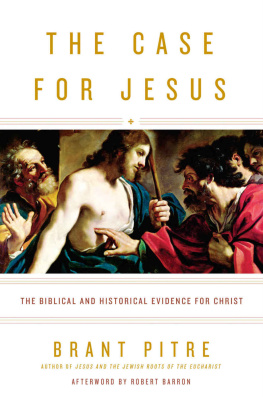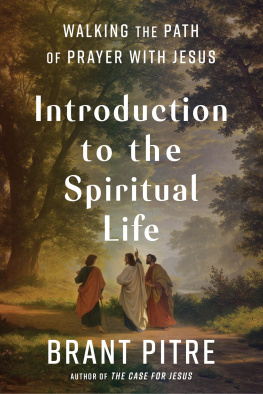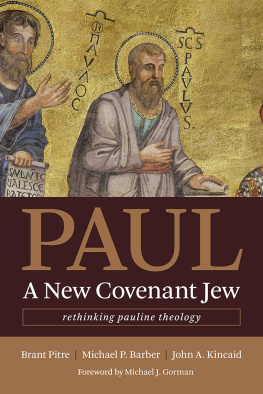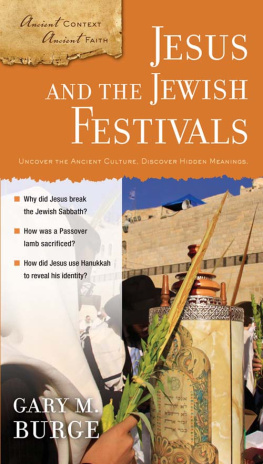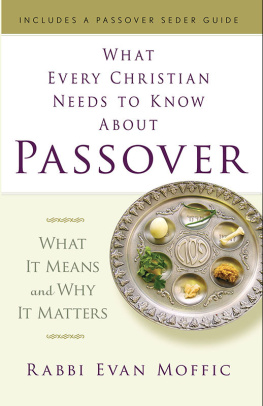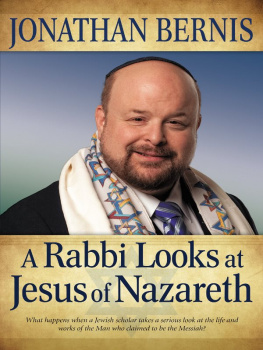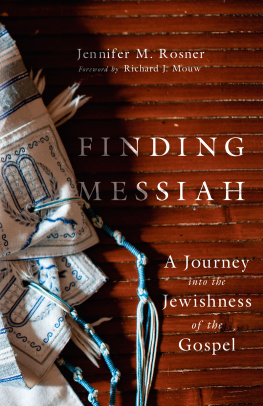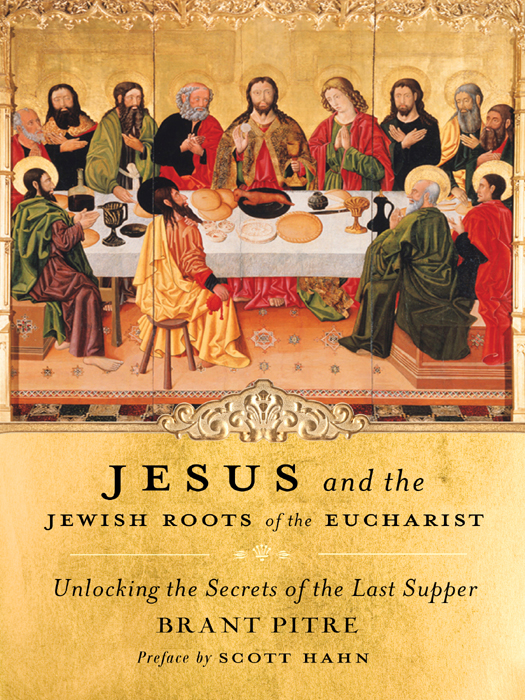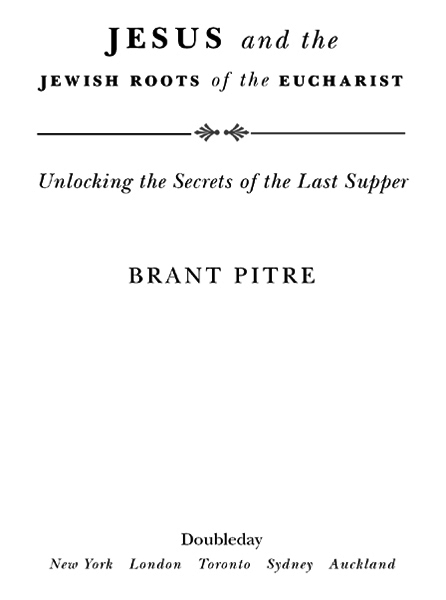NOTE : All scripture quotations are from the Revised Standard Version Catholic Edition (Toronto: Thomas Nelson & Sons, 1966). All emphasis in quotations is the authors.

Copyright 2011 by Brant Pitre
All rights reserved. Published in the United States by Doubleday Religion, an imprint of the Crown Publishing Group, a division of Random House, Inc., New York. www.doubledayreligion.com
DOUBLEDAY and the DD colophon are registered trademarks of Random House, Inc.
Nihil Obstat: Monsignor Francis J. McAree, Censor Librorum Imprimatur: Most Reverend Dennis J. Sullivan, Auxiliary Bishop and Vicar General, Archdiocese of New York
The Nihil Obstat and Imprimatur are official declarations that a book or pamphlet is free of doctrinal or moral error. No implication is contained therein that those who have granted the Nihil Obstat or Imprimatur agree with the content, opinions, or statements expressed.
Library of Congress Cataloging-in-Publication Data
Pitre, Brant James. Jesus and the Jewish roots of the Eucharist: unlocking the secrets of the Last Supper / Brant Pitre.1st ed. 1. Lords SupperHistory. 2. Catholic ChurchRelationsJudaism. 3. JudaismRelationsCatholic Church. I. Title.
BV825.3.P58 2011
234.163dc22 2010024979
eISBN: 978-0-385-53185-6
Jacket design: Jessie Sayward Bright
Jacket art: The Last Supper by The Perea Master Christies
Images Ltd./SuperStock
v3.1
For Elizabeth
CONTENTS
FOREWORD
By Scott Hahn
At our remove of two thousand years, it seems natural for us to look upon Jesus crucifixion as a sacrifice. Christians are heirs to a long tradition of talking that way, praying that way, thinking that way. But first-century Jews who witnessed the event would not and could not have seen the crucifixion as a sacrifice. It bore none of the marks of a sacrifice in the ancient world. On Calvary there was no altar and no credentialed priest. There was indeed a death, but it took place apart from the Temple, which was the only valid place of sacrifice in Judaism, and even outside the walls of the holy city.
St. Paul, however, made the connections for his generation, and especially for his fellow Jews. In First Corinthians, after introducing the word of the cross (1:18), he calls Christ our paschal lamb who has been sacrificed (5:7). Thus he makes the connection between the Passover celebrated as the Last Supper and the crucifixion on Calvary.
Indeed, it was that first Eucharist that transformed Jesus death from an execution to an offering. At the Last Supper he gave his body to be broken, his blood to be poured out, as if on an altar.
As Paul retold the story of the Last Supper (1 Corinthians 11:2325), he spoke of the event in sacrificial terms. He quotes Jesus as calling it the new covenant in my blood, an evocation of Moses words as he made a sacrificial offering of oxen: Behold the blood of the covenant (Exodus 24:8). It was the sacrificial blood that ratified the covenant, because Moses said so, in the one instance, and because Jesus said so in the other.
Paul also quotes Jesus calling the Supper a remembrance, which was another technical term for a specific type of Temple sacrifice (the memorial offering).
And just in case we missed any of those connections, Paul compares the Christian Supper (the Eucharist) with the sacrifices of the Temple (1 Corinthians 10:18) and even with pagan sacrifices (1 Corinthians 10:1921). All sacrifices, he says, bring about a communion, a fellowship. The offerings of idolatry bring about a communion with demons, but the Christian sacrifice brings about a communion with the body and blood of Jesus (1 Corinthians 10:16).
Pauls vision of the Passion is stunning. He shows us that it is not merely about how much Jesus suffered, but how much he loves. Love transforms suffering into sacrifice.
The death on Calvary was not simply a brutal and bloody execution. Jesus death had been transformed by his self-offering in the Upper Room. It had become the offering of an unblemished paschal victim, the self-offering of a high priest who gave himself for the redemption of others. He is both priest and victim. For Christ loved us and gave himself up for us, a fragrant offering and sacrifice to God (Ephesians 5:2). That is love: the total gift of self.
The Eucharist infuses that love into us, uniting our love with Christs, our sacrifice with his. Saint Paul preached: I appeal to you therefore, brethren, by the mercies of God, to present your bodies as a living sacrifice, holy and acceptable to God, which is your spiritual worship (Romans 12:1). Note that he speaks of bodies in the plural, but sacrifice in the singular. For we are many, but our sacrifice is one with Jesus own, which is once for all (see Hebrews 7:27, 9:12, 9:26, 10:10).
Paul teaches us that the Eucharist is ordered to the cross, and the cross is ordered to the resurrection. It is the crucified and resurrected humanity of Jesus that Christians consume in Holy Communion. We come to it by way of suffering, but we receive the Host as a pledge of lasting glory, and we have the grace to endure the rest.
This is something we cannot appreciate fully until we have learned to see it as it was in the beginning, as it was for those first Jewish Christians, who saw an old, familiar world ending and a new one descending as a heavenly Jerusalem. This beautiful book by Dr. Brant Pitre gives us all we need for that appreciation of what was, so that we can see, ever more clearly, what is now and ever shall be, world without end.
In the World to Come there is no eating or drinking but the righteous sit with crowns on their heads, feasting on the brightness of the divine presence, as it says, And they beheld God, and did eat and drink (Exodus 24:11).
Babylonian Talmud, Tractate Berakoth 17a
[The priests in the Temple] used to lift up [the golden table] and exhibit the Bread of the Presence on it to those who came up for the festivals, saying to them, Behold, Gods love for you!
Babylonian Talmud, Tractate Menahoth 29a
I NTRODUCTION
I will never forget that day. I was a college sophomore and engaged to be married. It was a beautiful spring morning, and my future bride and I were driving through our hometown to visit her pastor to talk about the wedding. We were as happy as could be. There was just one small problem: I was a cradle Catholic, and Elizabeth was a Southern Baptist. As a result, we had our differences of opinion over how to interpret the Bible but had come to respect each others beliefs even where we disagreed. For this reason, we had big hopes of bringing our two families together in what we then referred to as an ecumenical wedding service, one that would be respectful of both families traditions.


